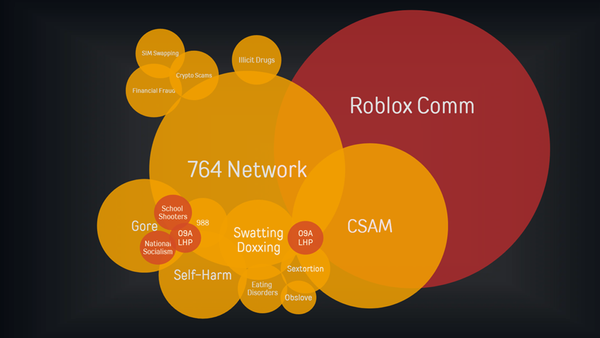The 764 Network: How Predators Exploit Children Through Gaming and Social Media

A Hidden Terror Network Preying on Vulnerable Youth
A disturbing new threat has emerged from the shadows of the internet, targeting children as young as nine years old through seemingly innocent online games and social media platforms. The "764" network, named after the partial zip code of its teenage founder, represents one of the most sophisticated and dangerous child exploitation operations law enforcement has ever encountered.
The FBI is investigating at least 250 subjects who are tied to violent online networks commonly referred to as '764' but includes many offshoot networks and names, with all 55 FBI field offices across the country involved in these investigations. What makes this network particularly alarming is not just its scale, but its deliberate targeting of children through platforms they use daily for entertainment and social connection.
BREAKING - 764 member Kyle Spitze's dad ARRESTED for intimidating and trying to silence his son's victims.
— Bx (@bx_on_x) July 25, 2025
Early on in our investigation and before Kyle Spitze's arrest, we tracked down his dad, Michael Spitze, and Ken Silva @JD_Cashless interviewed him on the phone.
Michael… pic.twitter.com/gu1EVOsfFZ
The Birth of a Digital Nightmare
The 764 network originated in 2021 when then-15-year-old Bradley Chance Cadenhead of Stephenville, Texas, who used the username "Felix" on Discord, founded the group. Cadenhead, who was bullied in school before dropping out in 2021, learned to groom and extort minors on a sextortion Discord server named CVLT. The number "764" itself comes from the partial zip code of Stephenville, Texas, where Cadenhead lived.
What began as a small Discord group has evolved into a global phenomenon. Since the launch of the initial 764 group, which garnered a couple of hundred Discord followers, 764 has become a global movement, with an array of offshoots and subgroups that often rebrand and change their names to help keep social media companies and law enforcement from tracking them.

How Predators Infiltrate Children's Digital Worlds
The 764 network has perfected the art of digital deception, using children's favorite platforms against them. Predators are scanning online games like Minecraft and Roblox for young girls. They also prowl X, formerly known as Twitter, Instagram and Facebook groups about self-harm and eating disorders, for girls who may be especially vulnerable.

The grooming process follows a calculated pattern:
Initial Contact and Trust Building
Predators posing as peers build trust, convince their victims to send explicit photos, and then use that material to exert control. 764 members employ several techniques to lure victims into these private spaces, including offering in-game rewards or virtual currency for games like Roblox, or feigning romantic interest to coerce the victim into sharing personal or compromising information.
Psychological Manipulation
One of the most common tactics is love bombing and getting into these fake online relationships. The predators create elaborate personas, often posing as teenagers themselves, to establish emotional connections with their targets.
Escalation and Control
Once trust is established, the demands escalate rapidly. Some of them got her to cut their usernames into her... And, basically, what they are requesting from the victims just keeps getting worse and worse and worse and worse. Victims are coerced into increasingly disturbing acts, including self-harm, creating explicit content, and even harming family pets.
The Platforms They Exploit
Gaming Platforms
On Roblox, predators have been known to lure children via in-game chat, grooming them under the guise of friendship or shared gaming interests. Some abusers create custom games or avatars that subtly mimic 764 symbolism to identify fellow group members or prey on vulnerable players.
These groups operate virtually in very accessible online spaces such as social media platforms, applications (apps) and online games (such as Discord, Telegram, Roblox, Minecraft, Twitch and Steam).

Social Media and Messaging Apps
On Discord, 764-affiliated users set up private servers where minors are manipulated into joining through peer pressure, threats, and blackmail. These servers have hosted graphic content, shared coercion tactics, and coordinated efforts to target specific children.
The network has adapted to platform restrictions by constantly evolving their methods. Once a potential victim is identified, 764 members will attempt to lure them into a private space, typically on Discord or Telegram. Invitations to these private spaces—as well as files shared with the victim—often contain keyloggers or IP loggers, enabling members to gain access to the victim's personal information without their knowledge or consent.

The Ideology Behind the Terror
The 764 network isn't just about exploitation—it's driven by a nihilistic ideology aimed at societal destruction. The defendants and their co-conspirators around the world used the CSAM and other gore and violent material to create digital "Lorebooks," which NVEs used as digital currency within the 764 network — traded, archived in encrypted "vaults," and used as a means to recruit new members or maintain status within the network.
As Scott described it, one of the main goals of 764 and similar networks is to "sow chaos" and "bring down society." That's why the FBI's Counterterrorism Division and the Justice Department's National Security Division are now looking at 764 and its offshoots as a potential form of domestic terrorism, even coining a new term to characterize the most heinous actors: "nihilistic violent extremists."
The Devastating Impact on Victims
The psychological warfare employed by 764 members has led to tragic consequences. Investigators say the group's actions have resulted in teens initiating bomb threats, death by suicide and harming family pets as 764 members threaten devotees with blackmail if they do not comply and the threats only escalate from there with some victims reporting "swatting" at their homes.
Real Cases, Real Consequences
Last year, in classic New England town of Vernon, Connecticut, local police arrested the girl -- a former honor roll student -- for conspiring with a 764 devotee overseas to direct bomb threats at her own community. When police searched her devices, they found pornographic photos of her, photos depicting self-mutilation, and photos of her paying homage to 764.
The mother confirms what investigators tell us -- once 764 members have any sensitive information or photo of a girl, they threaten to expose her -- to her family or school -- if she won't do what they want.
Law Enforcement Response
The scale of the threat has prompted an unprecedented law enforcement response. In April 2025, federal authorities announced the arrest of two key leaders: Leonidas Varagiannis, also known as War, 21, a citizen of the United States residing in Thessaloniki, Greece, and Prasan Nepal, also known as Trippy, 20, of High Point, North Carolina.
"These defendants are accused of orchestrating one of the most heinous online child exploitation enterprises we have ever encountered — a network built on terror, abuse, and the deliberate targeting of children," said Attorney General Pamela Bondi.
Global Reach and Violence
The network's influence extends far beyond the United States. European 764 and affiliated group members were responsible for at least three stabbing sprees between 2022 and 2025. The violence isn't limited to exploitation—members have been connected to real-world attacks and terrorism.
The 764 network has also been linked to recent school shootings in the United States. COE researchers have found that both the 15-year-old shooter who killed two people at Abundant Life Christian School in Madison, Wisconsin, in December 2024, and the 2025 Antioch school shooter engaged with 764-related content online.
Warning Signs for Parents
Law enforcement officials have identified key indicators that parents should watch for:
Behavioral Changes
- If a child is wearing long-sleeved clothing or trying to cover up their body on hot days, that could be a sign of self-harm
- Changes in personality, mood, or sleeping patterns
- Secretive behavior around devices and online activities
- Unexplained injuries to family pets
Digital Red Flags
- They are on mobile apps like Discord, Telegram or other encrypted communications platforms for which you have no visibility as a parent
- Sudden interest in violent or disturbing content
- New "friends" online who seem too interested in personal information
- Reluctance to discuss online activities
Platform Responses and Ongoing Challenges
Major platforms have acknowledged the threat but struggle to keep pace with the network's adaptability. "The actions of 764 are appalling and have no place on Discord or in society," the company said in a statement. "Since 2021, when Discord first became aware of 764, disrupting the group and its sadistic activity has been among our Safety team's highest priorities".
However, even removing thousands of accounts each month has proved insufficient. The targeted users start new accounts and swiftly reconvene.
Protecting Our Children: A Call to Action
The 764 network represents a new evolution in online predation—one that combines traditional exploitation tactics with extremist ideology and sophisticated technology. "Right now, I would say the digital threat is the biggest threat to children," said Detective Sergeant Christopher Camm.
For Parents:
- Maintain open communication with children about online safety
- Regularly monitor children's online activities and friend lists
- Enable parental controls on all devices and applications
- Be aware of the platforms your children use and understand their risks
- Trust your instincts—if something seems wrong, investigate further
For Communities:
- Support law enforcement efforts to combat online predation
- Advocate for stronger platform accountability measures
- Educate other parents and community members about these threats
- Report suspicious online behavior to authorities immediately
Look who was just arrested for threatening one of Kyle's victims? 👀
— Ken Silva (@JD_Cashless) July 25, 2025
Michael Spitze, whom I interviewed last year, allegedly tried bribing one of Kyle's minor victims.
The victim also told the father that Kyle said he indeed killed his mother, who purportedly died of an OD last… https://t.co/6OJMy1x6pi pic.twitter.com/X1xwfKOiCz
The Road Ahead
The fight against networks like 764 requires sustained effort from law enforcement, technology companies, parents, and communities. "Your child is living an entire second life on that phone," said Det. Camm. "The biggest problem we see is that a lot of these children do not know they're in trouble until it's too late".
As these networks continue to evolve and adapt, so too must our responses. The safety of our children in digital spaces requires vigilance, education, and action from all stakeholders. Only through coordinated efforts can we hope to protect the most vulnerable members of our society from these predators who hide behind screens and exploit the very technologies designed to connect and entertain our children.
The 764 network serves as a stark reminder that the internet, for all its benefits, can be a dangerous place for children. But with awareness, preparation, and decisive action, we can work to ensure that our children's digital worlds remain spaces for learning, creativity, and safe social connection—not hunting grounds for those who would do them harm.
If you suspect a child is being exploited online, contact the National Center for Missing and Exploited Children's CyberTipline at CyberTipline.org or call 1-800-THE-LOST (1-800-843-5678). For immediate danger, contact local law enforcement or call 911.









